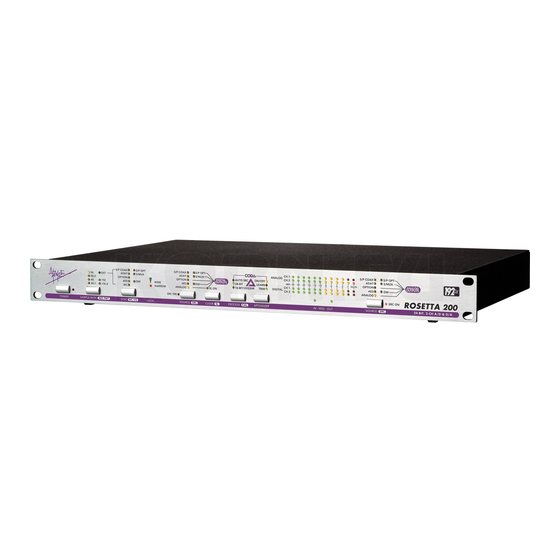Advertisement
Quick Links
Download this manual
See also:
User Manual
Aptomizer: White paper
Introduction:
The Rosetta 200 will be the fi rst Apogee
product to include Apogee's newly devel-
oped optimizer: "The Aptomizer". The Apto-
mizer is a digitally controlled analog process
maximizing the recording levels of analog
to digital conversion in music and sound
recording. The result of the procedure will be
an optimal use of the available bit resolution
and therefore produce the best possible sig-
nal to noise ration and the lowest distortion.
The problem:
The word length of any type of PCM conversion dictates the maximum theoretical dynamic
range. For example a 16-bit system allows for 96dB of dynamic range and a 24-bit system for
144 dB. Again, this is the theoretical range; in real life most 24-bit converters do not go beyond
120dB, because of limitations in chip fabrication, analog noise and limited voltage on the power
rails. However, music and sound in general hardly ever need such dynamics. For instance: a full
orchestra's dynamic range does not go beyond 100dB, not to mention the sound system on which
the music is being reproduced.
The catch is not the dynamic range, the catch is in distortion and the signal to noise ratio.
Contrary to analog recording, digital distortion decreases with higher levels. The more bits that
are being utilized, the higher the resolution; the lower the distortion, the lower the fi xed noise-
fl oor. A good analogy for this phenomenon is digital photography; the resolution of the digital
camera determines the detail of the fi nal picture.So an optimal recording level is vital for a high
quality recording.
On the other side of the spectrum, the process of PCM recording is very unforgiving with regards
to "overs". In other words, when all of the bits have been used and the amplitude of the signal
to be converted is higher then the maximum resolution allows, the A/D converter will produce a
series of maximum values, which will be perceived as clipping. This results in massive and very
unpleasant distortion when reproduced.
Any recording engineer has experienced the art of fi nding the proper recording level; high enough
to keep distortion and noise low and low enough to ensure unexpected peaks will pass the con-
version process without clipping. This can be a tedious process, especially when the end product
is a production-master requiring the most optimal levels.
Solutions:
• Automatic Gain Control: This is the "low" end solution. The process adjusts the recording level
based on the content of the material recorded. The disadvantage is the usually slow response
time of this process, resulting in the clipping of peak material and inconsistency in the perceived
loudness of the overall recorded material.
• The use of compressors and limiters:This can work effectively, but these devices do affect the
dynamics and "sound" of the recorded material and increase distortion.
APOGEE ELECTRONICS CORPORATION
www.apogeedigital.com
Advertisement

Summary of Contents for Apogee Rosetta 200
- Page 1 For example a 16-bit system allows for 96dB of dynamic range and a 24-bit system for 144 dB. Again, this is the theoretical range; in real life most 24-bit converters do not go beyond 120dB, because of limitations in chip fabrication, analog noise and limited voltage on the power rails.
- Page 2 Aptomizer level and engage soft limit to avoid “overs”. The last Aptomizer setting will always be stored and retrieved by the Rosetta 200 and only when Learn Mode is engaged will the settings be changed.









